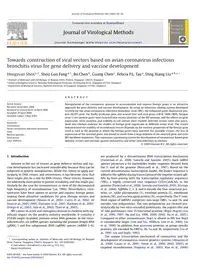
2009 Towards construction of viral vectors based on avian coronavirus infectious bronchitis virus for gene delivery and PDF
Preview 2009 Towards construction of viral vectors based on avian coronavirus infectious bronchitis virus for gene delivery and
Journal of Virological Methods 160 (2009) 48–56 Contents lists available at ScienceDirect Journal of Virological Methods journal homepage: www.elsevier.com/locate/jviromet Towards construction of viral vectors based on avian coronavirus infectious bronchitis virus for gene delivery and vaccine development Hongyuan Shen a,1, Shou Guo Fang a,1, Bo Chen b, Guang Chen c, Felicia P.L. Tay a, Ding Xiang Liu a,b,c,∗ a Institute of Molecular and Cell Biology, 61 Biopolis Drive, Proteos, Singapore 138673, Singapore b School of Biological Sciences, Nanyang Technological University, 60 Nanyang Drive, Singapore 637551, Singapore c Department of Biological Sciences, National University of Singapore, Singapore 117543, Singapore Article history: Received 14 October 2008 Received in revised form 14 April 2009 Accepted 20 April 2009 Available online 3 May 2009 Keywords: Coronavirus Avian coronavirus infectious bronchitis virus Reverse genetics Viral vector Gene delivery a b s t r a c t Manipulation of the coronavirus genome to accommodate and express foreign genes is an attractive approach for gene delivery and vaccine development. By using an infectious cloning system developed recently for the avian coronavirus infectious bronchitis virus (IBV), the enhanced green fluorescent pro- tein (EGFP) gene, the firefly luciferase gene and several host and viral genes (eIF3f, SARS ORF6, Dengue virus 1 core protein gene) were inserted into various positions of the IBV genome, and the effects on gene expression, virus recovery, and stability in cell culture were studied. Selected viruses were also inocu- lated into chicken embryos for studies of foreign gene expression at different tissue level. The results demonstrated the stability of recombinant viruses depends on the intrinsic properties of the foreign gene itself as well as the position at which the foreign genes were inserted. For unstable viruses, the loss of expression of the inserted genes was found to result from a large deletion of the inserted gene and even IBV backbone sequences. This represents a promising system for development of coronavirus-based gene delivery vectors and vaccines against coronavirus and other viral infections in chicken. © 2009 Elsevier B.V. All rights reserved. 1. Introduction Interest in the use of viruses as gene delivery vectors and vac- cine development has increased considerably because they can be subjected to genetic manipulation. While this seems to apply par- ticularly to DNA viruses and retroviruses, it has become clear that there might also be a role for RNA viruses. These viruses, however, are inherently more prone to genetic instability, and this might par- ticularly be the case for coronaviruses in view of the documented high frequency of recombination (Lai, 1996). Nevertheless, coro- naviruses have been shown to accept and express foreign genes, making them attractive candidates for gene therapy vectors and vaccine development (Alonso et al., 2002; Curtis et al., 2002; de Haan et al., 2003, 2005; Enjuanes et al., 2001; Hackney et al., 2003; Ortego et al., 2002; Sola et al., 2003; Thiel et al., 2003). IBV causes an acute and contagious disease in chickens with sig- nificant impact on the poultry industry worldwide. It contains a 27.6 kb single-stranded, positive-sense RNA genome. In the virus- infected cells, six mRNA species, including the genome-length RNA (gRNA) 1 and five subgenomic RNA (sgRNA) species (mRNA 2–6), ∗ Corresponding author at: Institute of Molecular and Cell Biology, 61 Biopolis Drive, Proteos, Singapore 138673, Singapore. Tel.: +65 65869581. E-mail address:
